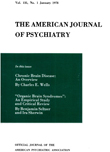IMMEDIATE AND LONG-TERM SYMPTOMATIC COURSE OF PSYCHIATRIC OUTPATIENTS
Abstract
Two populations of psychiatric outpatients totalling 109 were given placebos and the effect on their reported level of distress noted immediately and after 1 and 2 weeks on the placebo. Patients in both populations received special tests and measures before and after receiving placebo. Over half the patients in each group were re-examined after 3 and 2 years respectively, at which time some again received a placebo.
In both groups, whatever the criterion used or the time interval, a greater proportion of patients reported improvement than reported getting worse. The mean discomfort score dropped sharply during the first interview, before as well as after administration of the placebo, then tended to increase, but not back to the initial level. Maintenance on placebo did not increase the effect. The amount of improvement was related to amount of distress reported initially, and symptoms of anxiety and depression showed more improvement than somatic ones.
Patients showed little consistency in their responsiveness to placebo at different administrations, and we have been unable definitely to relate their responses to personality variables.
Various hypotheses to account for these findings are examined, with special reference to the role of cognitions in emotional distress and its relief.
Access content
To read the fulltext, please use one of the options below to sign in or purchase access.- Personal login
- Institutional Login
- Sign in via OpenAthens
- Register for access
-
Please login/register if you wish to pair your device and check access availability.
Not a subscriber?
PsychiatryOnline subscription options offer access to the DSM-5 library, books, journals, CME, and patient resources. This all-in-one virtual library provides psychiatrists and mental health professionals with key resources for diagnosis, treatment, research, and professional development.
Need more help? PsychiatryOnline Customer Service may be reached by emailing [email protected] or by calling 800-368-5777 (in the U.S.) or 703-907-7322 (outside the U.S.).



